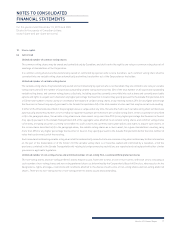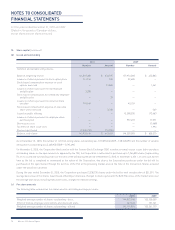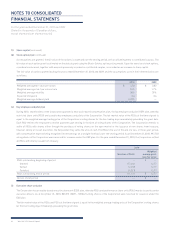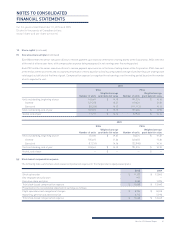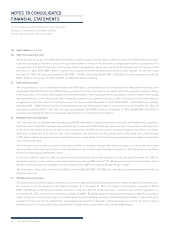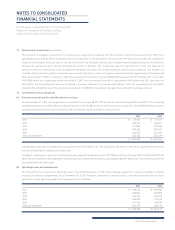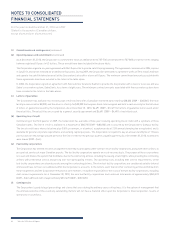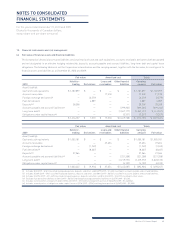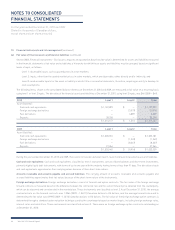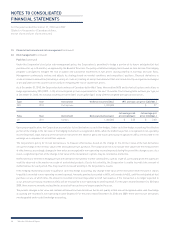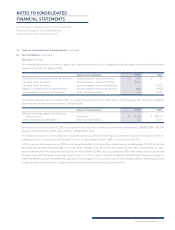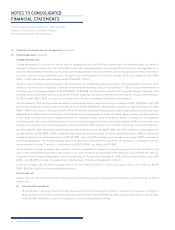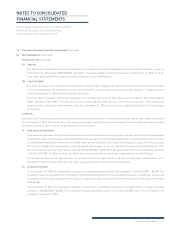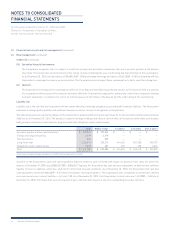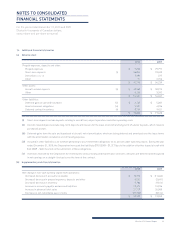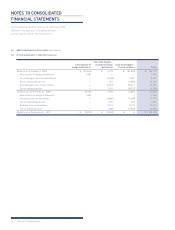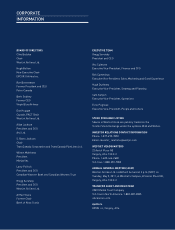Westjet 2010 Annual Report Download - page 89
Download and view the complete annual report
Please find page 89 of the 2010 Westjet annual report below. You can navigate through the pages in the report by either clicking on the pages listed below, or by using the keyword search tool below to find specific information within the annual report.
WestJet 2010 Annual Report 87
NOTES TO CONSOLIDATED
FINANCIAL STATEMENTS
For the years ended December 31, 2010 and 2009
(Stated in thousands of Canadian dollars,
except share and per share amounts)
13. Financial instruments and risk management (continued)
(a) Fair value of fi nancial assets and fi nancial liabilities (continued)
Fuel derivatives: Fuel derivatives consist of swaps, collars and call option contracts. The fair value of the fuel derivatives is determined using
inputs, including quoted forward prices for commodities, foreign exchange rates and interest rates, which can be observed or corroborated in the
marketplace. The fair value of the swap contracts is estimated by discounting the difference between the contractual strike price and the current
forward price. These instruments are classifi ed as level 2.
The fair value of the collar and call option contracts are estimated by the use of a standard option valuation technique. These instruments are
classifi ed as level 2. As at December 31, 2010, for the period that the Corporation is hedged, the closing forward curve for crude oil ranged from
approximately US $91 to US $94 (2009 – US $79 to US $84), with the average forward foreign exchange rate used in determining the fair value
being 1.0032 (2009 – 1.0536) Canadian dollars to US dollars.
Deposits: The fair value of the deposits that relate to purchased aircraft and airport operations approximates their carrying amounts as they are
at a fl oating market rate of interest. These instruments are classifi ed as level 1.
Long-term debt: The fair value of the Corporation’s fi xed-rate long-term debt is determined by discounting the future contractual cash fl ows
under current fi nancing arrangements at discount rates obtained from the lender, which represent borrowing rates presently available to the
Corporation for loans with similar terms and remaining maturities. As at December 31, 2010, rates used in determining the fair value ranged
from 2.00% to 2.74% (2009 – 2.28% to 3.27%). The fair value of the Corporation’s variable-rate long-term debt approximates its carrying value,
as it is at a fl oating market rate of interest.
Obligations under capital leases: The fair value of the Corporation’s capital lease obligations approximates their carrying value due to their
short-term remaining maturities and total value due.
(b) Gain (loss) on derivatives recorded at fair value
The following table presents the components of gain (loss) on derivatives included on the consolidated statement of earnings for the years ended
December 31, 2010 and 2009:
2010 2009
Gain on designated fuel derivatives $ 44 $ 5,617
Loss on foreign exchange options (78) (3,789)
$ (34) $ 1,828
(c) Risk management
The Corporation is exposed to market, credit and liquidity risks associated with its fi nancial assets and liabilities. From time to time, the
Corporation will use various fi nancial derivatives to reduce market risk exposures from changes in foreign exchange rates, interest rates and jet
fuel prices. The Corporation does not hold or use any derivative instruments for trading or speculative purposes.
Overall, the Corporation’s Board of Directors has responsibility for the establishment and approval of the Corporation’s risk management
policies. Management continually perform risk assessments to ensure that all signifi cant risks related to the Corporation and its operations have
been reviewed and assessed to refl ect changes in market conditions and the Corporation’s operating activities.
Fuel risk
The airline industry is inherently dependent upon jet fuel to operate and, therefore, the Corporation is exposed to the risk of volatile fuel prices.
Fuel prices are impacted by a host of factors outside the Corporation’s control, such as signifi cant weather events, geopolitical tensions,
refi nery capacity, and global demand and supply. For the year ended December 31, 2010, aircraft fuel expense represented approximately 29%
(2009 – 28%) of the Corporation’s total operating expenses.


